Jason Lowery - Softwar, part II
| Dear Hiveans | Liebe Hiver | Queridos Hiveanos |
|---|---|---|
| This is part 2 of my favourite excerpts from the book "Softwar" (goodreads) by Jason Lowery. | Dies ist Teil 2 meiner Lieblingsauszüge aus dem Buch "Softwar" (goodreads) von Jason Lowery. | Esta es la segunda parte de mis extractos favoritos del libro "Softwar" (goodreads) de Jason Lowery. |
The need for Power Projectors to establish consensus on the state of ownership and chain of custody of resources hinges on the assumption that pack Members actually value those resources in the first place. If Members don’t assign value to the resources over which Power Projectors compete for control authority, then the Power Projectors’ control authority over those objects is practically useless. … This control action is a major factor for human packs, because sapiens often compete to exercise control authority over immaterial resources with abstract value like money.
An unfortunate side effect for using physical power as the basis for settling disputes, establishing control authority over physical resources, and achieving consensus on the legitimate state of ownership and chain of custody of property is that physical power projection is prone to causing injury. When done kinetically (i.e. using forces to displace masses), displays of physical power can lead to injury. And when physical strength and aggression is disproportionately rewarded with food and mating rights, it’s easy to see why this protocol can lead to life-threatening injuries. Nature mitigates this risk by making pack animals instinctively disinclined to fatally injure each other. For example, when wolves infight to establish their pecking order, it is not uncommon for one wolf to successfully pin down their opponent. The dominant wolf will press its teeth against the jugular of the opponent, but it will not bite. For existential reasons, the wolf is instinctively disinclined to kill a fellow member of the pack; it needs every member of the pack to hunt for prey, secure the pack against predators, and to survive and prosper for as long as possible. This explains why many animals do not battle to the death over food and mating rights; they battle to the point where they can discern that one is clearly more powerful and aggressive than the other.
- Very interesting.
Nevertheless, using physical power as the basis for setting disputes, establishing control authority over internal resources, and achieving consensus on the legitimate state of ownership and chain of custody of property doesn’t necessarily have to cause so much physical injury. Nature shows us there are different ways to project physical power to establish intraspecies dominance hierarchies. Different animals have adopted different strategies to perform the same function, and we can take note of them. For example, mammalian carnivores and herbivores employ much different power projection strategies for establishing their dominance hierarchies.
[... ] Nevertheless, wolves still end up killing other wolves. Humans end up killing other humans, and so on. The simple fact of the matter is that physical power-based resource control protocols are destined to cause lethal injury; it’s an unfortunate side effect of a demonstrably necessary protocol for survival and prosperity. We know this because the pack animals which survive in the wild are the ones who use this protocol. Is physical injury wasteful? It certainly seems to be. But it also seems to be the case that the risk of physical injury is a price that natural selection demands for survival; a price that Earth’s top survivors are willing to pay.
Brain tissue requires about 20 times more power than muscle tissue. The most energy-consuming part of our brain is the modern part, the neocortex, which is used for higher-level processing and abstract thinking. For shrew-like mammals, the neocortex represents about 10% of total brain volume. The average mammal’s brain volume is 40% neocortex. Primates have an above-average neocortex volume of 50%. But even a primate’s neocortex is small compared to anatomically modern humans. A staggering 80% of sapient brain volume is neocortex. … Humans can afford to power their large neocortices because of the energy abundance they achieved by learning how to control fire. Humans unlock far more energy per unit of food consumed than other animals thanks to their ability to cook.
… Learning how to control fire and gain access to exogenous energy caused sapient brains to grow so quickly that they outpaced the growth of their own pelvises and birth canals. Combined with their tendency to walk upright, these sudden anatomical changes cause sapiens to have far more complex and painful childbirths than other primates. Sapient heads are so large that they must be born approximately 50% prematurely with only partially assembled skulls and necks just to fit through their mother’s birth canal.
For this reason, sapiens are significantly more fragile and helpless at birth compared to other mammals, and they must go through a longer adolescent period to account for having to incubate outside the womb. But as the saying goes, “the juice is worth the squeeze.” A sapiens’ massive neocortex is the source of the most significant power projection technique observed on Earth. … It should be noted that sapiens are first and foremost hunter-gathering nomads, having spent only the last 5% of their history on Earth doing anything except traveling the world searching for fauna and flora to eat. Their overclocked, overpowered, and oversized neocortices are especially useful for these activities because they help their hosts perform advanced pattern finding. The ability to connect dots between sensory input information enhances sapiens’ ability to detect and exploit patterns of behavior in surrounding fauna and flora for improved hunting and gathering. The advanced dot-connecting and pattern-finding capability of a brain is colloquially known as intelligence. The more an animal can use their brain to connect dots between their sensory inputs or detect valid patterns of behavior within their environment, the more intelligent the animal is perceived to be. Not surprisingly, with 80% of their brain volume comprised of advanced pattern-finding neocortex hardware fueled by excess energy and fire power, modern sapient brains are the most intelligent on Earth.
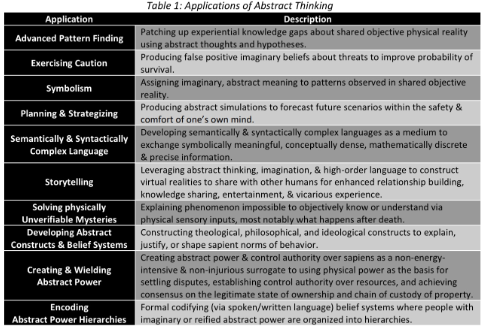
As sapiens further honed their abstract thinking skills, they graduated from imagining highly realistic hunting simulations to imagining all sorts of other abstract realities. Their overclocked and hyperactive neocortices started to assign abstract meaning to recurring patterns in their campfires and in the stars above their heads. They started using abstract thinking not just to connect dots and fill gaps in experiential knowledge, but also to account for phenomenon they can’t physically verify using sensory inputs at all (most notably what happens after death). Perhaps the most disruptive application of abstract thinking to emerge after planning and strategizing was semantically and syntactically complex, high-order language. High-order language enabled humans to share their individually-imagined, abstract realities together much more easily. This allowed them to synchronize their imaginary thoughts together well enough to create large-scale shared abstract realities.
Over time, this process of assigning symbolic meaning to otherwise meaningless audible and visual patterns became increasingly more complex, until the nature of the meaning assigned to various lexical items could be changed based off their composition, in a process we now call semantics. Eventually, humans learned to combine various symbols with different semantic meaning into discrete units of discourse called words, then combine them into mathematically formal and discrete structures like phrases, sentences, and grammar in a process we now call syntactics.
Most high-order spoken or written languages (including and especially the languages we use to program computers) are composed of these same two components. Shapes and sounds are imbued with abstract and symbolic meaning (semantics) and then combined into some type of mathematically discrete and formal structure (syntactics), giving rise to complex language that we can used to convey both highly abstract and highly precise thoughts. This type of communication is not necessary for survival or forming bonds because humans spent most of their existence without it, but higher order language is extremely useful as a medium of exchange for conceptually dense and mathematically discrete information, through which people can use to share abstract and precise thoughts with each other. The pinnacle of humans using symbolism to assign semantic and syntactically complex meaning to things in order to connect neocortices together is machine code. Using symbolic reasoning and language techniques like Boolean logic, sapiens can turn practically any physical state-changing phenomenon into information that can be stored or transferred to other people or machines. The crown jewel of higher-order semantically and syntactically complex language is machine code – the ability to communicate with and through machines. This remarkable application of abstract thinking is what makes the internet work. The internet is just people communicating to other people through physical state-changing mechanisms using Boolean logic. A clear limitation of higher-order language is that it only works for people who have taken the time to memorize the semantic meaning and syntactic structure of the language protocol. Whereas it takes no effort to learn how to communicate with strangers using singing, laughing, and baby talk, higher-order language takes years, even decades, to learn. Sapiens can and often go their entire lives with nothing more than a shallow appreciation of the semantic and syntactic depth of the language protocols they learn. This is perhaps because higher-order language is merely a means to an end, not an end in and of itself. Most sapiens don’t learn higher-order language for the sake of knowing the semantic and syntactic details of a higher-order language, they learn it for the sake of peering into the minds of other sapiens and connecting abstract realities together through a process called storytelling.
- Fascinating.
By assigning symbolic meaning to random shapes and sounds, then using syntactics to assemble them together into a common topological or audible structure, humans can exchange information with high levels of precision to communicate their abstract ideas. This capability allows sapiens to do something remarkable: connect their imaginations together to form a single, shared abstract reality.
[...] In other words, storytelling is an abstract superpower. Hence why Edward Bulwer-Lytton observed that “the pen is mightier than the sword.” A more technically accurate way to say the same phrase would be “higher-order syntactically and semantically complex written language can influence, organize, and direct more unified physical power than a single person swinging a sword can.” People can achieve things far beyond their physical limits using the right combination of stories.
Storytelling is how money and currencies work. Money is nothing more than a belief system – one of many completely fictional stories told by storytellers that people voluntarily choose to believe in. By believing in the same money (i.e. medium for transferring financial information), people can and will cooperate with each other at scales which far exceed their physical and physiological limits. On the flip side, when money breaks down, cooperation breaks down. If people stop believing in the same money, cooperation comes crashing down. A collapsing money is a collapsing society; it has ended several empires. Because money is a belief system, the manipulation of money (supply of money) is technically a form of passive-aggressive psychological abuse. People who distort the medium for transferring financial information are systemic predators who prey on people’s belief system, eroding their ability to cooperate with each other and contributing to the collapse of society. The most successful moneys have been those which physically constrain this type of systemic exploitation (e.g. gold).
| Great points. Money manipulators are predators. | Gute Argumente. Geldmanipulatoren sind Räuber. | Grandes puntos. Los manipuladores del dinero son depredadores. |
“Those who tell the stories rule society.” - Plato
Abstract power and their corresponding dominance hierarchies (what the author calls abstract power hierarchies) represent a belief system to which many people subscribe simply because they want to believe that there are viable alternatives to physical conflict as the basis for settling intraspecies disputes and establishing intraspecies pecking order. It’s a good story which motivates people to work together and cooperate at large scales. The idea that sapiens have somehow outsmarted natural selection and used their neocortices to find a viable substitute for physical confrontation to settle intraspecies disputes and establish interspecies pecking order is an extremely attractive idea. And as we know from the concepts provided about storytelling, the more sapiens can get behind a common idea, the more they can sum their physical power together and literally move mountains. Unfortunately, abstract belief systems are fictional stories. Our beliefs about a better way to settle our intraspecies disputes and establish our intraspecies pecking order also clearly don’t work as well as we wish they would work, because sapiens still routinely engage in physical confrontation to settle intraspecies disputes and establish intraspecies pecking order the exact same way animals do.
To better understand how vulnerable sapient belief systems are to psychological exploitation and abuse, we can use adversarial thinking to analyze how to create and codify abstract power. The reader is invited to assume you are a systemic predator who wants to psychologically exploit a human population’s belief system for your own personal advantage. What is the most important thing you need the population to believe in so that you can have extraordinary amounts of imaginary power and control authority over their valuable resources? One thing that you could do is convince them to believe that using physical power to establish their dominance hierarchy is morally “bad.” You could convince them there are ideological alternatives to physical power for establishing control authority over their resources and achieving consensus on the legitimate state of ownership and chain of custody of their property. Perhaps the population might become concerned that you could abuse your abstract power to exploit them. If that’s the case, then you could convince them that imaginary logical constraints encoded into rules of law are fully sufficient at protecting them against systemic predators like you who can exploit imaginary power. Once the population has been convinced that imaginary power hierarchies encoded into rules of law are incontrovertibly better solutions than physical power, then you could simply place yourself at the top of that abstract power hierarchy by masquerading as the morally, ethically, ideologically, or theologically fit candidate for the job. If you are successful, the population will bend to your will and do your bidding for you, labor for you, kill for you, give you their most valuable resources and worship you like a god.
Weapon technology
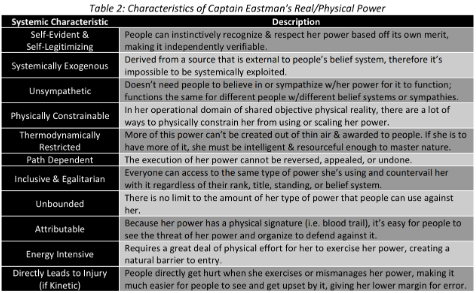
If we combine all these characteristics together, we can expect a sociotechnical cooperation system that uses physical power to settle disputes, manage resources, and establish pecking order to have precisely the same kind of complex emergent behavior observed in the physical power projection competitions of nature, where those who emerge as the top power projectors have survived a rigorous but objectively fair natural selection process which separates those who are stronger, more intelligent, better organized, and more resourceful from those who are demonstrably unfit for survival.
[…] In direct contrast to real/physical power, we have abstract/imaginary power. Figure 46 provides a breakdown of the characteristics of abstract power using another real example. Here, Chief Justice Dudley is pictured presiding over the Supreme Court of Gibraltar. Like all abstract power, Chief Justice Dudley’s power is imaginary; it’ doesn’t physically exist anywhere except exclusively within people’s collective imaginations. It’s neither self-evident nor self-legitimizing, which means people can’t instinctively recognize or independently verify it based off its own merit. It’s also systemically endogenous to people’s belief system, making it highly vulnerable to systemic exploitation and abuse.
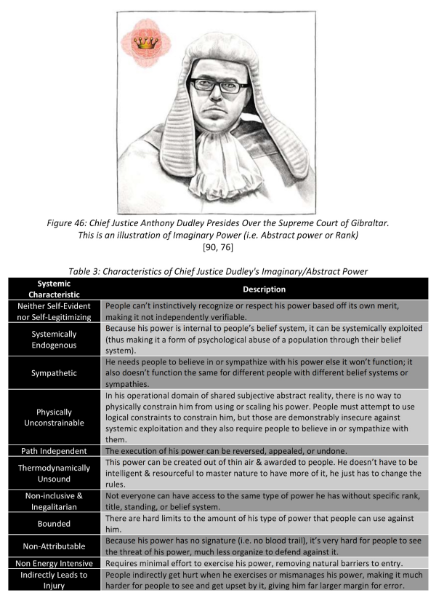
Nevertheless, there are benefits to imaginary/abstract power. For starters, this kind of power requires minimal energy to exercise and has practically no natural barriers to entry, making it extremely efficient and easy-to-adopt. It is also less directly attributable to physical injury, making it ostensibly more moral. In other words, because imaginary power doesn’t involve physical confrontation, it’s ostensibly “good.” However, the reader should note that the underlying argument of this thesis is that abstract power is so dysfunctional that it directly motivates people to engage in large-scale physical confrontations.
To illustrate the ambiguous nature of rhetoric, consider President John F. Kennedy’s famous inaugural address written by Theodore Sorenson, perhaps most remembered for its “ask not what your country can do for you; ask what you can do for your country” statement. This chain of logic suggests American citizens exist for the sake of serving their government, which is directly contradictory to the philosophical intent of the American Constitution and the founding fathers who proposed the exact opposite theory that governments exist to serve the people. As previously discussed, Americans are insurrectionists – people who are overtly defiant to abstract power – dismissive of rank, disloyal to their king, capable of and highly motivated to kill thousands of redcoats to delegitimize their oppressive king’s abstract power. The US Constitution gives American citizens the right to free speech and the right to bear arms for the explicit purpose of empowering American citizens to delegitimize the abstract power of their government if it becomes too abusive or systemically exploitative, just like the British monarchy did in the 1700s.
The first types of people from which populations sought permission and approval appear to be Paleolithic shamans. These shamans were eventually replaced by Neolithic priests and god-kings. By the bronze and iron ages, cultural evolution (and a whole lot of physical conflict) changed god-kings into regular kings, senators, or emperors. Today, the highest-ranking positions wielding the most amount of abstract power are called kings, presidents, senators, and prime ministers. These high-ranking positions sit within the formally-encoded abstract power hierarchies described in Table 4.

Something important to note about today’s abstract power hierarchies is that they’re exponentially more centralized and asymmetrically powerful now than they have ever been in the history of human civilization. The valuable resources of approximately eight billion people are now controlled by something like ten thousand high-ranking people across the world who have the overwhelming majority of all abstract power. While highly energy efficient, this type of social system comes at the cost of creating systemic security vulnerabilities. Never in human history have so many valuable resources been more centrally controlled by such a small ruling class (it would have been mathematically impossible in the past due to population sizes, even though there were a larger number of independent city states). People are living in an abstract belief system where the combined global resources of all sapiens are governed by only 0.0001% of its population.

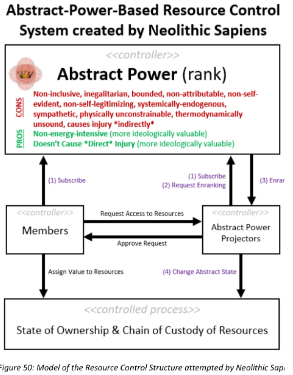
Few people get to have rank, and not everyone gets the right to vote. Instead, only an extremely small sample of the population gets to have rank required to vote on their rules, making the system far less representative of the will of the people who choose to use rank rather than watts. In this sense, terms like “representative democracy” are oxymorons akin to terms like “the people’s republic,” because a very small number of votes (0.0001% in the case of the US representative democracy) is, statistically speaking, not a highly representative sample size of the population’s beliefs and interests.
For example, the resources and interests of 330 million Americans is controlled by less than 1,000 high-ranking people. This means Americans are limited to the abstract power of less than 1,000 people to represent and secure their interests. If the majority of those 1,000 high-ranking people collude at the expense of the people they ostensibly represent, then 330 million people are mathematically guaranteed not to be able to overturn their vote. They can’t access more rank, and they can’t outvote or overturn collusion, resulting in a state of systemic oppression which can only be solved via physical confrontation (hence why republics and democracies descend into civil wars and revolutions).
Rule makers can meddle with the rules, bait-and-switch the rules, or deliberately design their logic to have exploitable properties which benefit one group of people at the expense of others. Rule makers can design the rules to award themselves with more voting power than other people, or they can make one side’s rank and votes carry more mathematical weight and control authority than another side’s rank and votes by simply changing the logic of the voting system. With discrete mathematical precision, rule makers can design loopholes, backdoors, trapdoors, and zero-days into the system’s design logic which nullify people’s ability to represent and secure themselves. They can award themselves with veto power. They can exploit voting protocols via jerrymandering or counterfeiting or other common forms of fraud. There are many ways abstract power can be systemically exploited, and there are many ways to deliberately
design rules of law so that they are intentionally exploitable without detection from the public.
Physical power, on the other hand, is impossible to systemically exploit in this manner because nobody has the capacity to write any of the rules. Watts are systemically exogenous and fully independent from anybody’s belief system, or any ruleset designed or encoded by any person for that matter. Physical power exists in an ontologically separate plane of knowledge than abstract power, predating human-made constructs like rank and authority by at least 14 billion years.
They created imaginary power and authority in the form of rank and title to serve as a surrogate to real power. As Charles Foster summarizes, “with title came a sense of entitlement.”
After the emergence of domestication and agriculture and abstract power hierarchies, the growth rate of sapient brains started to reverse course and to shrink (as all animal brains do when they become domesticated, even in fish). Highly infectious diseases emerged. Famines emerged. Occupational diseases emerged. Dietary deficiencies emerged. Iron deficiencies emerged. Severe mental health deficiencies emerged. Closed-minded and intolerant monocultures emerged. Political competitions and infighting emerged. Excessive resources gave rise to excessively large tribes. Populations grew so large that sapiens started to experience something they hadn’t experienced before: anonymity. The ability to be anonymous in excessively large tribes translates to the ability to prey on tribe members without the natural deterrence of social and reputational damage. Consequently, crime emerged, and with it the need for a formal mechanism of deterrence and delivery of punishments. Police emerged, and with it came the systemic vulnerabilities of the police becoming criminal organizations in and of themselves, giving rise to one of many forms of corruption within abstract power hierarchies. On top of all these other “features” to blossom from the fertile soil of modern agrarian society, so too did the profession of warfighting - a farless lethal byproduct of agrarian society in comparison to infectious disease, dietary deficiencies, and famine, but one that seems to get far more people’s attention.
Ironically, agriculture was invented by sapiens in pursuit of energy efficiency – to not have to spend so much time and energy hunting and gathering their own food. It was also intended to reduce physical injury – to not have to risk personal injury securing access to food. Tragically, in their pursuit of safer and more energy-efficient methods for gaining and maintaining access to food resources, sapiens ended up creating systems which take more energy to maintain and result in more fighting and injury to keep secure. They traded the burden of having to chase down caribou with the burden of having to kill each other at unprecedented and unnatural scales to keep their arbitrarily partitioned plots of highly vulnerable irrigated land safe against neighboring abstract power hierarchies or abusive god-kings.
Clearly there are benefits to our modern way of life, but it’s certainly not all sunshine and rainbows. The tragedy of modern civilization is that most sapiens alive today have only ever known isolated, sedentary, tediously laborious lifestyles teeming with inequality and systemic exploitation of their belief systems, compared to the egalitarian, adventurous, dynamic lifestyles sapiens once had. Modern agrarian domesticated sapiens engorge themselves on cheap, artificial, and easy food. They chase after imaginary wealth and power, all while chasing the illusion of security and prosperity, blissfully unaware of the systemic hazards they place themselves in, and the eye-watering levels of exploitation their belief systems routinely get subjected to. In the process of domesticating and entrapping animals, sapiens domesticated
and entrapped themselves, and now they are incapable of knowing how utterly unhappy they are because they have never seen, known, or experienced anything except the inside of their agrarian cage.
| It's a long book, and I will follow up with 1 or 2 parts of excerpts. | Es ist ein langes Buch, und ich werde 1 oder 2 weitere Teile schreiben. | Es un libro largo, y seguiré con 1 o 2 partes con extractos. |
Have a great day,
zuerich


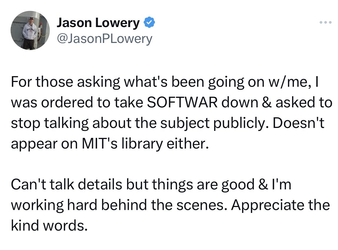
!MEME
Copying/Pasting content (full or partial texts, video links, art, etc.) with adding very little original content is frowned upon by the community.
Publishing such content could be considered exploitation of the "Hive Reward Pool".
Please refrain from copying and pasting, or decline the rewards on those posts going forward.
If you believe this comment is in error, please contact us in #appeals in Discord.